
The masque was a form of festive courtly entertainment that flourished in 16th- and early 17th-century Europe, though it was developed earlier in Italy, in forms including the intermedio. A masque involved music, dancing, singing and acting, within an elaborate stage design, in which the architectural framing and costumes might be designed by a renowned architect, to present a deferential allegory flattering to the patron. Professional actors and musicians were hired for the speaking and singing parts. Masquers who did not speak or sing were often courtiers: the English queen Anne of Denmark frequently danced with her ladies in masques between 1603 and 1611, and Henry VIII and Charles I of England performed in the masques at their courts. In the tradition of masque, Louis XIV of France danced in ballets at Versailles with music by Jean-Baptiste Lully.

John Lyly was an English writer, playwright, courtier, and parliamentarian. He was best known during his lifetime for his two books Euphues: The Anatomy of Wit (1578) and its sequel Euphues and His England (1580), but is perhaps best remembered now for his eight surviving plays, at least six of which were performed before Queen Elizabeth I. Lyly's distinctive and much imitated literary style, named after the title character of his two books, is known as euphuism. He is sometimes grouped with other professional dramatists of the 1580s and 1590s like Christopher Marlowe, Robert Greene, Thomas Nashe, George Peele, and Thomas Lodge, as one of the so-called University Wits. He has been credited by some scholars with writing the first English novel, and as being 'the father of English comedy'.

David Martin Bevington was an American literary scholar. He was the Phyllis Fay Horton Distinguished Service Professor Emeritus in the Humanities and in English Language & Literature, Comparative Literature, and the college at the University of Chicago, where he taught since 1967, as well as chair of Theatre and Performance Studies. "One of the most learned and devoted of Shakespeareans," so called by Harold Bloom, he specialized in British drama of the Renaissance, and edited and introduced the complete works of William Shakespeare in both the 29-volume, Bantam Classics paperback editions and the single-volume Longman edition. After accomplishing this feat, Bevington was often cited as the only living scholar to have personally edited Shakespeare's complete corpus.

Dido, Queen of Carthage is a short play written by the English playwright Christopher Marlowe, with possible contributions by Thomas Nashe. It was probably written between 1587 and 1593, and was first published in 1594. The story focuses on the classical figure of Dido, the Queen of Carthage. It tells an intense dramatic tale of Dido and her fanatical love for Aeneas, Aeneas' betrayal of her and her eventual suicide on his departure for Italy. The playwrights relied on Books 1, 2, and 4 of Virgil's Aeneid as primary source.

The Merry Devil of Edmonton is an Elizabethan-era stage play; a comedy about a magician, Peter Fabell, nicknamed the Merry Devil. It was at one point attributed to William Shakespeare, but is now considered part of the Shakespeare Apocrypha.
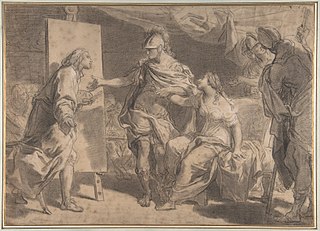
Campaspe, or Pancaste, was a supposed mistress of Alexander the Great and a prominent citizen of Larissa in Thessaly. No Campaspe appears in the five major sources for the life of Alexander and the story may be apocryphal. The biographer Robin Lane Fox traces her legend back to the Roman authors Pliny, Lucian of Samosata and Aelian's Varia Historia. Aelian surmised that she initiated the young Alexander in love.

The Maid's Metamorphosis is a late Elizabethan stage play, a pastoral first published in 1600. The play, "a comedy of considerable merit," was published anonymously, and its authorship has been a long-standing point of dispute among scholars.
Cynthia's Revels, or The Fountain of Self-Love is a late Elizabethan stage play, a satire written by Ben Jonson. The play was one element in the Poetomachia or War of the Theatres between Jonson and rival playwrights John Marston and Thomas Dekker.
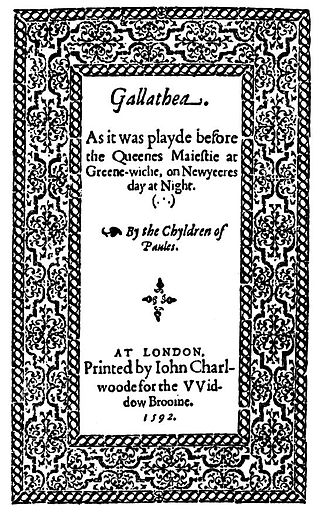
Gallathea or Galatea is an Elizabethan era stage play, a comedy by John Lyly. The first record of the play's performance was at Greenwich Palace on New Year's Day, 1588 where it was performed before Queen Elizabeth I and her court by the Children of St Paul's, a troupe of boy actors. At this point in his literary career, Lyly had already achieved success with his prose romance Euphues and was a writer in residence at Blackfriars theatre. The play is set in a village on the Lincolnshire shore of the Humber estuary and in the neighboring woods. It features a host of characters including Greek deities, nymphs, fairies, and some shepherds.

Endymion, the Man in the Moon is an Elizabethan era comedy by John Lyly, written circa 1588. The action of the play centers around a young courtier, Endymion, who is sent into an endless slumber by Tellus, his former lover, because he has spurned her to worship the ageless Queen Cynthia. The prose is characterised by Euphuism, Lyly's highly ornate, formalised style, meant to convey the intelligence and wit of the speaker. Endymion has been called "without doubt, the boldest in conception and the most beautiful in execution of all Lyly's plays." Lyly makes allusions to ancient Greek and Roman texts and traditional English folklore throughout the play. While the title and characters are references to the myth of Endymion, the plot sharply deviates from the classical story and highlights contemporary issues in Elizabeth I's court through its allegorical framework.
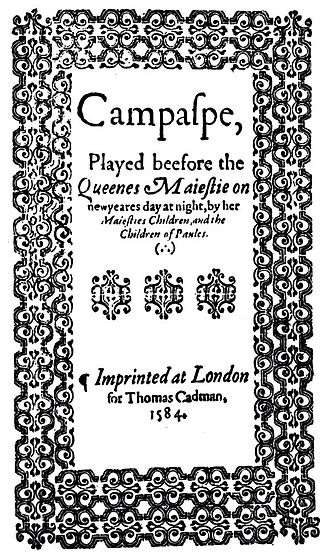
Campaspe is an Elizabethan era stage play, a prose comedy by John Lyly based on the story of the love triangle between Campaspe, a Theban captive, the artist Apelles, and Alexander the Great, who commissioned him to paint her portrait. Widely considered Lyly's earliest drama, Campaspe was an influence and a precedent for much that followed in English Renaissance drama, and was, according to F. S. Boas, "the first of the comedies with which John Lyly inaugurated the golden period of the Elizabethan theatre".
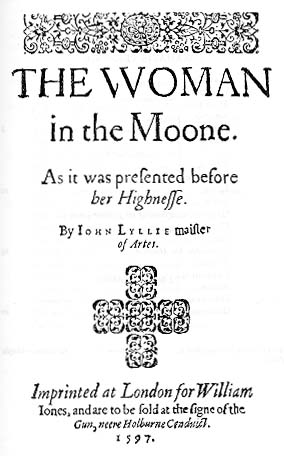
The Woman in the Moon is an Elizabethan era stage play, a comedy written by John Lyly. Its unique status in that playwright's dramatic canon – it is the only play Lyly wrote in blank verse rather than prose — has presented scholars and critics with a range of questions and problems.

Love's Metamorphosis is an Elizabethan era stage play, an allegorical pastoral written by John Lyly. It was the last of his dramas to be printed.
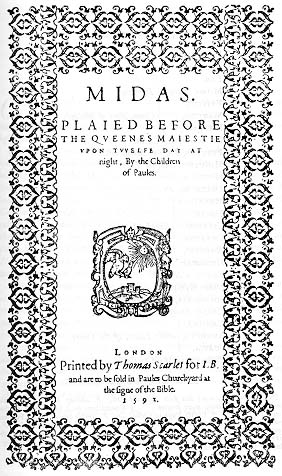
Midas is an Elizabethan era stage play, a comedy written by John Lyly. It is arguably the most overtly and extensively allegorical of Lyly's allegorical plays.
Edward Allde was an English printer in London during the Elizabethan and Jacobean eras. He was responsible for a number of significant texts in English Renaissance drama, including some of the early editions of plays by William Shakespeare.
The Wisdom of Doctor Dodypoll is a later Elizabethan stage play, an anonymous comedy first published in 1600. It is illustrative of the type of drama staged by the companies of child actors when they returned to public performance in that era.

Sapho is an opera in three acts by Charles Gounod, premiered 16 April 1851 at Salle Le Peletier of the Paris Opera. The libretto was by Émile Augier after the life of the poet Sappho of Lesbos. The creation of the work was given an impetus by, and provided a central role for, the mezzo-soprano Pauline Viardot.

Sappho and Phaon is an 1809 neoclassical painting by the French painter Jacques-Louis David of Cupid, Sappho and her lover Phaon. It was commissioned by Prince Nikolai Yusupov for his Moika Palace and is now the only painting by David in the Hermitage Museum in Saint Petersburg.

Timoclea or Timocleia of Thebes is a woman whose story is told by Plutarch in his Life of Alexander, and at greater length in his Mulierum virtutes. According to Plutarch's biography of Alexander the Great, when his forces took Thebes during Alexander's Balkan campaign of 335 BC, Thracian forces pillaged the city, and a Thracian captain raped Timocleia. After raping her, the captain asked if she knew of any hidden money. She told him that she did, and led him into her garden, and told him there was money hidden in her well. When the Thracian captain stooped to look into the well, Timocleia pushed him down into it, and then hurled heavy stones down until the captain died.


















